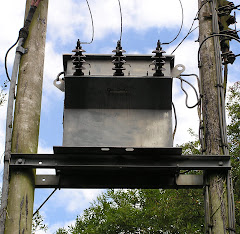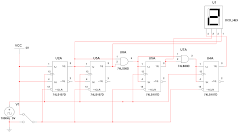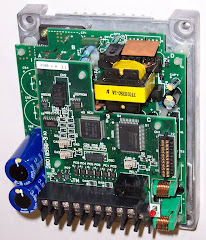Electronic waste
This article needs additional citations for verification.Please help improve this article by adding reliable references. Unsourced material may be challenged and removed. (November 2007)
The introduction of this article is too short.To comply with Wikipedia's lead section guidelines, it should be expanded to summarize the article.
Electronic waste, "e-waste" or "Waste Electrical and Electronic Equipment" ("WEEE") is a waste type consisting of any broken or unwanted electrical or electronic appliance. Recyclable electronic waste is sometimes further categorized as a "commodity" while e-waste which cannot be reused is distinguished as "waste". Both types of e-waste have raised concern considering that many components of such equipment are considered toxic and are not biodegradable. Responding to these concerns, many European countries banned e-waste from landfills in the 1990s.
The European Union would further advance e-waste policy in Europe by implementing the Waste Electrical and Electronic Equipment Directive in 2002 which holds manufacturers responsible for e-waste disposal at end-of-life. Similar legislation has been enacted in Asia, with e-waste legislation in the United States limited to the state level due to stalled efforts in the United States Congress regarding multiple e-waste legislation bills.
Due to the difficulty and cost of recycling used electronics as well as lacklustre enforcement of legislation regarding e-waste exports, large amounts of used electronics have been sent to countries such as China, India, and Kenya, where lower environmental standards and working conditions make processing e-waste more profitable.[1]
Contents
1 Definition
2 Problems
3 Trends in disposal and recycling
4 List of substances contained in electronic waste
4.1 Substances in bulk
4.2 Elements in bulk
4.3 Elements in small amounts
4.4 Elements in trace amounts (alphabetical)
4.5 List of example applications of the above elements and substances
5 See also
6 References
7 External links
Definition
Some activists define "Electronic waste" to include all secondary computers, entertainment devices electronics, mobile phones and other items, whether they have been sold, donated, or discarded by their original owner. This definition includes used electronics which are destined for reuse, resale, salvage, recycling or disposal. Others define the reusable (working and repairable electronics) and secondary scrap (copper, steel, plastic, etc.) to be "commodities", and reserve the use of the term "waste" for residue or material which was represented as working or repairable but which was discarded by the buyer.
Debate continues over the distinction between "commodity" and "waste" electronics definitions. Some exporters may deliberately leave obsolete or non-working equipment mixed in loads of working equipment (through ignorance, or to avoid more costly treatment processes for 'bad' equipment). On the other hand, some importing countries specifically seek to exclude working or repairable equipment in order to protect domestic manufacturing markets. "White box" computers ('off-brand' or 'no name' computers) are often assembled by smaller scale manufacturers utilizing refurbished components. These 'white box' sales accounted for approximately 45% of all computer sales worldwide by 2004, and are considered a threat to some large manufacturers, who therefore seek to classify used computers as 'waste'.
While a protectionist may broaden the definition of "waste" electronics, the high value of working and reusable laptops, computers, and components (e.g. RAM), can help pay the cost of transportation for a large number of worthless "commodities". Broken monitors, obsolete circuit boards, short circuited transistors, and other junk are difficult to spot in a containerload of used electronics.
Until such time as equipment no longer contains such hazardous substances, the disposal and recycling operations must be undertaken with great care to avoid damaging pollution and workplace hazards, and exports need to be monitored to avoid "toxics along for the ride".
Problems
If treated properly, electronic waste is a valuable source for secondary raw materials. However, if not treated properly, it is a major source of toxins and carcinogens. Rapid technology change, low initial cost and even planned obsolescence have resulted in a fast growing problem around the globe. Technical solutions are available but in most cases a legal framework, a collection system, logistics and other services need to be implemented before a technical solution can be applied. Electronic waste represents 2 percent of America's trash in landfills, but it equals 70 percent of overall toxic waste.[2]
Due to lower environmental standards and working conditions in China, India, Kenya, and elsewhere, electronic waste is being sent to these countries for processing – in most cases illegally. Guiyu in Shantou region of China, and Delhi and Bangalore in India, all have electronic waste processing areas.[3] Uncontrolled burning, disassembly, and disposal are causing environmental and health problems, including occupational safety and health effects among those directly involved, due to the methods of processing the waste. Trade in electronic waste is controlled by the Basel Convention.
Electronic waste is of concern largely due to the toxicity and carcinogenicity of some of the substances if processed improperly. Toxic substances in electronic waste may include lead, mercury, cadmium. Carcinogenic substances in electronic waste may include polychlorinated biphenyls (PCBs). A typical computer monitor may contain more than 6% lead by weight, much of which is in the lead glass of the CRT. Capacitors, transformers, PVC insulated wires, PVC coated components that were manufactured before 1977 often contain dangerous amounts of polychlorinated biphenyls.[4] Up to thirty-eight separate chemical elements are incorporated into electronic waste items. The unsustainability of discarding electronics and computer technology is another reason for the need to recycle – or perhaps more practically, reuse – electronic waste.
E-waste is often exported to developing countries
Electronic waste processing systems have matured in recent years following increased regulatory, public, and commercial scrutiny, and a commensurate increase in entrepreneurial interest. Part of this evolution has involved greater diversion of electronic waste from energy intensive, down-cycling processes (eg. conventional recycling) where equipment is reverted to a raw material form. This diversion is achieved through reuse and refurbishing. The environmental and social benefits of reuse are several: diminished demand for new products and their commensurate requirement for virgin raw materials (with their own environmental externalities not factored into the cost of the raw materials) and larger quantities of pure water and electricity for associated manufacturing, less packaging per unit, availability of technology to wider swaths of society due to greater affordability of products, and diminished use of landfills.
Challenges remain, when materials cannot or will not be reused, conventional recycling or disposal via landfill often follow. Standards for both approaches vary widely by jurisdiction, whether in developed or developing countries. The complexity of the various items to be disposed of, cost of environmentally sound recycling systems, and the need for concerned and concerted action to collect and systematically process equipment are the resources most lacked -- though this is changing. Many of the plastics used in electronic equipment contain flame retardants. These are generally halogens added to the plastic resin, making the plastics difficult to recycle.
Trends in disposal and recycling
WEEE Man
In the 1990s some European countries banned the disposal of electronic waste in landfills. This created an e-waste processing industry in Europe.
In Switzerland the first electronic waste recycling system was implemented in 1991 beginning with collection of old refrigerators. Over the years, all other electric and electronic devices were gradually added to the system. Legislation followed in 1998 and since January 2005 it has been possible to return all electronic waste to the sales points and other collection points free of charge. There are two established PROs (Producer Responsibility Organizations): SWICO mainly handling electronic waste and SENS mainly responsible for electrical appliances. The total amount of recycled electronic waste exceeds 10 kg per capita per year.[5][6][7]
The European Union has implemented a similar system under the Waste Electrical and Electronic Equipment Directive (WEEE 2002/96/EC). The WEEE Directive has now been transposed in national laws in all member countries of the European Union. The WEEE directive was designed to make equipment manufacturers financially or physically responsible for their equipment at its end-of-life under a policy known as extended producer responsibility (EPR). EPR was seen as a useful policy as it internalized the end-of-life costs and provided a competitive incentive for companies to design equipment with less costs and liabilities when it reached its end-of-life. However the application of the WEEE directive has been criticized for implementing the EPR concept in a collective manner and thereby losing the competitive incentive of individual manufacturers to be rewarded for their green design.[8] Since 13 August 2005, the electronics manufacturers became financially responsible for compliance to the WEEE directive. Under the directive, by the end of 2006 – and with one or two years' delay for the new EU members – every country has to recycle at least 4 kg of e-waste per capita per year.
Some states in recent years in the US developed policies banning CRTs from landfills due to the fear that the heavy metals contained in the glass would eventually leach into groundwater. Circuit boards also contain considerable quantities of lead-tin solders and are even more likely to leach into groundwater or become air pollution if managed in an incinerator. Indeed, a policy of "diversion from landfill" has been the driver for legislation in many states requiring higher and higher volumes of e-waste to be collected and processed separate from the solid waste stream. Today the e-waste recycling business is in all areas of the developed world a big and rapidly consolidating business. Unfortunately, increased regulation of e-waste and concern over the environmental harm which can result from toxic e-waste has raised disposal costs. This has had the unforeseen effect of providing brokers and others calling themselves recyclers with an incentive to export the e-waste to developing countries. This form of toxic trade was first exposed by the Basel Action Network (BAN) in their 2002 report and film entitled "Exporting Harm: The High-Tech Trashing of Asia".[9] Exporting Harm placed a spotlight on the global dumping of electronic waste, primarily from North America on a township area of China known as Guiyu. To this day in Guiyu, thousands of men, women and children are employed, in highly polluting, primitive recycling technologies, extracting the metals, toners, and plastics from computers and other e-waste. Because the United States has not ratified the Basel Convention or the Basel Ban Amendment, and has no domestic laws forbidding the export of toxic waste, BAN estimates that about 80% of the e-waste directed to recycling in the US does not get recycled there at all but is put on container ships and sent to countries such as China.[10][3] High Tech Trash: Digital Devices, Hidden Toxics, and Human Health by Elizabeth Grossman [Island Press, 2006, 2007.]
In developed countries, e-waste processing usually first involves dismantling the equipment into various parts — metal frames, power supplies, circuit boards, and plastics — which are separated, often by hand. Alternatively, material is shredded, and sophisticated expensive equipment separates the various metal and plastic fractions, which then are sold to various smelters and or plastics recyclers. From 2004 the state of California introduced a Electronic Waste Recycling Fee on all new monitors and televisions sold to cover the cost of recycling. The amount of the fee depends on the size of the monitor. That amount was adjusted on July 1, 2005 in order to match the real cost of recycling. Canada has also begun to take responsibility for electronics recycling. For example, in August of 2007 a fee similar to the one in California was added to the cost of purchasing new televisions, computers, and computer components in British Columbia. The new legislation made recycling mandatory for all of those products.
A typical electronic waste recycling plant as found in some industrialized countries combines the best of dismantling for component recovery with increased capacity to process large amounts of electronic waste in a cost effective-manner. Material is fed into a hopper, which travels up a conveyor and is dropped into the mechanical separator, which is followed by a number of screening and granulating machines. The entire recycling machinery is enclosed and employs a dust collection system. The European Union, South Korea, Japan and Taiwan have already demanded that sellers and manufacturers of electronics be responsible for recycling 75% of them.
Many Asian countries have legislated, or will do so, for electronic waste recycling.
The United States Congress is considering a number of electronic waste bills including the National Computer Recycling Act introduced by Congressman Mike Thompson (D-CA). This bill has continually stalled, however.
In the meantime, several states have passed their own laws regarding electronic waste management. California was the first state to enact such legislation, followed by Maryland, Maine, Washington and Minnesota. More recently, legislatures in Oregon and Texas passed their own laws.
List of substances contained in electronic waste
Substances in bulk
Polychlorinated biphenyls (PCBs), polyvinyl chloride (PVC), thermosetting plastics, epoxy resins, and fibre glass.
Elements in bulk
Lead, tin, copper, silicon, beryllium, carbon, iron and aluminium
Elements in small amounts
Cadmium, mercury, thallium[11]
Elements in trace amounts (alphabetical)
Americium, antimony, arsenic, barium, bismuth, boron, cobalt, europium, gallium, germanium, gold, indium, lithium, manganese, nickel, niobium, palladium, platinum, rhodium, ruthenium, selenium, silver, tantalum, terbium, thorium, titanium, vanadium, and yttrium.
List of example applications of the above elements and substances
Almost all electronics contain lead and tin (as solder) and copper (as wire and PCB tracks), though the use of lead-free solder is now spreading rapidly.
Lead: solder, CRT monitors (lead in glass), lead-acid batteries
Tin: solder, coatings on component leads
Copper: copper wire, printed circuit board tracks, component leads
Cadmium: light-sensitive resistors, corrosion-resistant alloys for marine and aviation environments
Aluminium: nearly all electronic goods using more than a few watts of power (heatsinks), electrolytic capacitors.
Beryllium oxide: filler in some thermal interface materials such as thermal grease used on heatsinks for CPUs and power transistors,[12] magnetrons, X-ray-transparent ceramic windows, heat transfer fins in vacuum tubes, and gas lasers.
Iron: steel chassis, cases and fixings
Silicon: glass, transistors, ICs, printed circuit boards.
Nickel and cadmium: nickel-cadmium batteries
Lithium: lithium-ion battery
Zinc: plating for steel parts
Gold: connector plating, primarily in computer equipment
Americium: smoke alarms (radioactive source)
Germanium: 1950s–1960s transistorised electronics (bipolar junction transistors)
Mercury: fluorescent tubes (numerous applications), tilt switches (pinball games, mechanical doorbells, thermostats)
Sulphur: lead-acid batteries
Carbon: steel, plastics, resistors. In almost all electronic equipment.
Polychlorinated biphenyls (PCBs) (prior to ban): in almost all 1930s–1970s equipment including capacitors, transformers, wiring insulation, paints, inks, and flexible sealants
See also
Electronics Portal
Waste Electrical and Electronic Equipment Directive
Electronic Waste Recycling Act
Basel Convention on the Control of Transboundary Movements of Hazardous Wastes and Their Disposal
Digger gold
Electronic Waste Recycling Fee
Free Geek - recycling and re-using computer equipment based on the 'Free to all' philosophy.
Green computing
Polychlorinated biphenyls - see Handling Procedures
Solving the E-waste Problem or StEP
RoHS
Computer recycling
Silicon valley toxics coalition
References
^ Where does all the e-waste go? Greenpeace International
^ Slade, Giles. "iWaste", Mother Jones, 2007-04-01. Retrieved on 2007-04-03.
^ BAN and SVTC. 2002. "Exporting Harm: The High-Tech Trashing of Asia". Seattle and San Jose: Basel Action Network and Silicon Valley Toxics Coalition, February 25, 2002. Available: http://www.ban.org/E-waste/technotrashfinalcomp.pdf
^ Karlyn Black Kaley, Jim Carlisle, David Siegel, Julio Salinas (October 2006). Health Concerns and Environmental Issues with PVC-Containing Building Materials in Green Buildings (pdf), Integrated Waste Management Board, California Environmental Protection Agency, USA, p.11. Retrieved on 2007-08-03.
^ Umwelt Schweiz, Accessed 24.11.06
^ Swico, Accessed 24.11.06
^ SENS, Accessed 24.11.06
^ Lost In Transposition?, Greenpeace Report, 27 September 2006, [1]
^ "High-Tech Trash", National Geographic Magazine, January 2008. [2]
^ America Ships Electronic Waste Overseas By Terence Chea, Associated Press, 11/18/07.
^ Chemical fact sheet — Thallium. Spectrum Laboratories. Retrieved on 2008-02-02.
^ Greg Becker, Chris Lee, and Zuchen Lin (Jul 2005). "Thermal conductivity in advanced chips — Emerging generation of thermal greases offers advantages". Advanced Packaging: pp.2-4. Retrieved on 2008-03-04.
^High Tech Trash: Digital Devices, Hidden Toxics, and Human Health by Elizabeth Grossman (Island Press, 2006, 2007) ^Where Computers Go to Die....And Kill by Elizabeth Grossman, Salon, April 2006
External links
The external links in this article may not follow Wikipedia's content policies or guidelines.Please improve this article by removing excessive or inappropriate external links.
The Secret Life of Cell Phonesan INFORM, Inc. Video Project
e-Waste Guide A knowledge base for the sustainable recycling of e-Waste
Indian e-Waste Guide A knowledge base for the sustainable recycling of e-Waste specific to India
European Commission WEEE page
RoHS directive (PDF)
WEEE directive (PDF)
US EPA's 'eCycling' Program
Inside the Digital Dump, a photoessay from Foreign Policy Magazine
BBC Article "Gadget recycling foxes consumers"
The Electronic Waste Problem
Greenpeace Electronic Waste Campaign
Greener Computing - covers eWaste and other green computing issues
Recent 'bust' illuminates underground electronics export business in Canada Canada.com accessed December 22, 2006
WEEE was not thought through
The e-waste problem in China
[hide]
v • d • e
Topics related to waste management
Anaerobic digestion · Composting · Eco-industrial park · Incineration · Landfill · Mechanical biological treatment · Radioactive waste · Reuse · Recycling · Regiving · Sewerage · Waste · Waste collection · Waste sorting · Waste hierarchy · Waste management concepts · Waste legislation · Waste treatment
Tuesday, April 22, 2008
Subscribe to:
Post Comments (Atom)





No comments:
Post a Comment